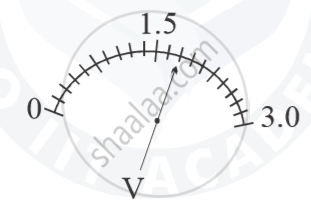Advertisements
Advertisements
प्रश्न
How should the two resistances of 2 ohms each be connected so as to produce an equivalent resistance of 1 ohm?
उत्तर
The two resistors of 2 Ω each should be connected in parallel combination to produce equivalent resistance of 1 Ω.
`1/R=1/R_1+1/R_2 `
`1/R=1/2+1/2`
or `1/R=2/2`
R=1 Ω
R = 1
Total resistance, R = 1 Ω
Resistance In parallel arangement is given by `
`1R=1R_1+1R_2`
`1R=12+12 or 1R=22 `
`R=1Ω `
APPEARS IN
संबंधित प्रश्न
What will be the change in the current if the potential difference is kept constant and the resistance of the circuit is made four times?
- It will remain unchanged.
- It will become four times.
- It will become one-fourth.
- It will become half.
When a 12 V battery is connected across an unknown resistor, there is a current of 2.5 mA in the circuit. Find the value of the resistance of the resistor.
Name the unit of electrical resistance and give its symbol.
Consider the sacle of voltmeter shown in the diagram and answer the following questions :

(a) What is the least count of the voltmeter?
(b) What is the reading shown by the voltmeter ?
(c) If the voltmeter is connected across a resistor of 20 `Omega` how much current is flowing through the resistor?
Define the following:
(i) Coulomb
(ii) Ohm
What are ohmic conductors? Give one exmaple. Draw a graph showing the current-voltage relationship for an ohmic conductor.
The ratio of the potential difference to the current is known as ________.
State macroscopic form of Ohm’s law.
The resistance of a nichrome wire at 0°C is 10Ω. If its temperature coefficient of resistivity of nichrome is 0.004/ °C, find its resistance of the wire at boiling point of water. Comment on the result.
What is the resistance of a conductor through which a current of 0.5 A flows when a potential difference of 2V is applied across its ends?
